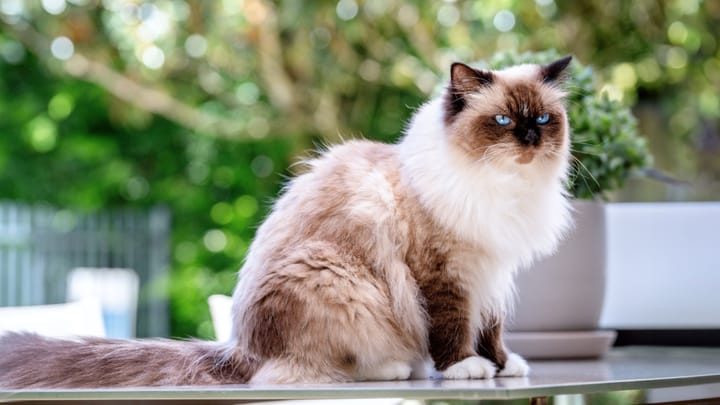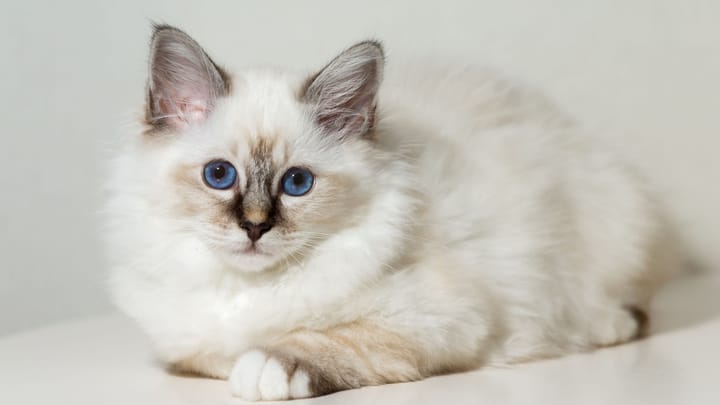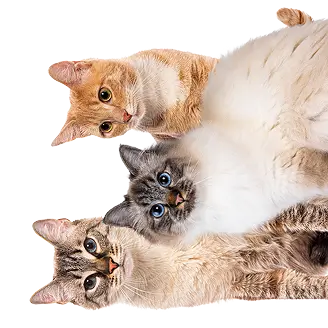Birman
Other name: The Sacred Cat of Burma


Even if their origins are rather vague, it appears that the Burmese is a truly French cat. Their mid-length and silky fur has the benefit of not getting tangled. These placid cats like to spend their time being cuddled by their owner, whom they follow like a shadow. They are very sociable and get along well with humans and animals of all ages...
|
Life expectancy |
The Birman has a life expectancy of between 12 and 15 years |
|
Temperament |
|
|
Adult size |
Female
Approximately 12 in
Male
Approximately 12 in
|
|
Adult weight |
Female
Between 4 and 9 lb
Male
Between 9 and 13 lb
|
|
Coat colour
Black / seal, blue / chocolate, lilac / lilac, cinnamon / cream / fawn, red All the above colours are only possible as part of a colourpoint coat. Their coat is only coloured in certain places, such as the ends of their tails, their faces, their ears and above their paws. The rest of their fur is white. A particular quirk is the little white ‘sock’ on each of their paws! |
Black Brown Red Cream Blue |
|
Type of coat
Their fur is longer around their necks and on their backs and sides. They have a very light undercoat. |
Long |
|
Eye colour
The blue should be as piercing as possible! |
Blue
|
|
Purchase price |
The Birman costs approximately 500£ |
The texture of a Birman’s fur is quite special. In fact, their hair never gets tangled. This makes them the perfect cat for those who love silky fur but hate daily brushing sessions!
More details about the Birman
Birman: Origins and history
No one really knows about the Birman’s origin...but there are plenty of rumours.
One rumour has it that a pair of sacred cats were imported to France by an American billionaire, who had stolen them from the temple of Lao Tsun, in Burma. The male died during the trip, but Sita, the female, gave birth to several kittens including Maldapour Doll, the ancestor of the Western Birman. Maldapour Doll was presented at the Paris exhibition in 1926, but, despite much research, it is impossible to confirm this breed’s origin.
The most likely story is that they originate from crossbreeding between a Siamese (from which it derives most of its characteristics), and a Persian. Today, the Birman is one of the 10 most popular breeds in the world.
Physical characteristics of the Birman
Birman are a medium-sized cats with broad bodies. They have a strong bone structure, round heads and ears that are as wide as they are long. They have beautiful full cheeks which line their distinctive Roman noses (which are hooked, short and straight). Their faces are neither pointed (like a Siamese) nor squished (like a Persian). Their bushy tail is average sized and is well proportioned to the rest of their bodies. Their mid-length fur is silky and whatever their coat colour, their legs are tipped with pretty white ‘socks’ that cover their big round paws.
Birman: Characteristics
Birman: Behaviour
Breed compatibility Birman
Birman: Purchase price
On average, a Birman kitten costs approximately £500. This price may vary depending on their breeder, lineage, age at purchase and even their sex.
It costs on average £25 / month to keep a Birman in good health.
Birman: Shedding
Average
This breed can shed a lot, however regular brushing avoids too many issues.
Birman: Grooming
Other than a weekly brushing, their fur requires no special attention. It is also a good idea to keep their eyes and ears as clean as possible.
Birman: Health
The Sacred Cat of Burma has a life expectancy of around 12 to 15 years.
Their mid-length coat allows them to withstand both hot and cold temperatures.
This breed doesn’t have a specific tendency to get fat, however they do need to expend some energy in order to maintain a normal weight. To help the cat avoid gaining weight, their diet should be adapted to their age and levels of activity.
Like many breeds, the Sacred Cat of Burma is predisposed to develop certain hereditary diseases which are detectable by blood test or oral smear:
- Hypertrophic cardiomyopathy is the thickening of the heart muscle. This disease can lead to heart failure due to arrhythmias, lung oedema, arterial thrombosis etc. Screening is done by means of an echocardiography examinatination, which is usually renewed annually. Treatment can be administered according to the results of the echocardiograph to improve the cat’s quality of life.
- Polycystic kidney disease is a disease that results in the development of cysts that prevent the kidney from functioning normally, and lead to incurable kidney failure. Veterinary care and a specialised diet can delay the disease and improve the quality of the cat’s life so that they can live longer.
- Mucopolysaccharidosis type VI is genetic disease that causes skeletal abnormalities.
Birman can also develop the same diseases as all other cats (oral diseases etc).
Once a Birman reaches the age of 7, it is advised that they have an annual check up with the vet to monitor their health.
Birman kittens are born entirely white and develop their colour after just a few days. This colour will continue to darken for the next 2-3 years, until it reaches its final shade.
No cross breeding is permitted.







